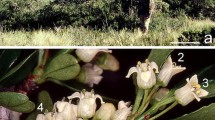Abstract
Pedicularis dendrothauma is an arboreal epiphytic hemiparasite that was recently discovered in Nepal. We present results of preliminary studies on its habitat, demography, hemiparasitism, flower development, and pollination. While showing a strong preference forAbies spectabilis trunks and branches as a substrate,P. dendrothauma also grows on other species of trees and shrubs in the understorey as well as on dead wood on the forest floor, and only very rarely is rooted in soil or on rocks, rooted in a bryophyte layer. Demographic monitoring of the population in 1999 and 2001 allows us to begin to predict longevity, average size of flowering plants, and survivorship and flowering probability on different substrates. We demonstrate that individual plants ofP. dendrothauma live at least four, and probably at least five years. Studies of haustoria show that the species has retained its hemiparasitic habit despite having moved from a terrestrial to an arboreal habitat. Flowering probability increases with plant size; an average flowering plant has five leaves and a longest leaf that measures 21.5 cm. Survivorship varies from substrate to substrate, with the greatest survivorship over a two year period occurring in plants growing on living trees. Flowering probability was the same for plants growing on living trees as it was for plants on dead wood. Studies of flower development suggest that plants growing high in the canopy proceeded through the stages of floral development more rapidly than plants nearer ground level. Despite many hours of field observation, the method of pollination remains a mystery; we suggest different possible pollination mechanisms.
Similar content being viewed by others
References
Ackerman J.D. (1986): Coping with the epiphytic existence: pollination strategies.Selbyana 9: 52–60.
Allard D.J. (2000):The subalpine fir forest zone of Lamjung Himal, Nepal: vegetation types, forest dynamics and human impacts. Ph.D. Thesis, University of Cambridge, Cambridge.
Berg R.Y. (1954): Development and dispersal of the seed ofPedicularis silvatica.Nytt Mag. Bot. 2: 1–60.
Goldblatt P., Manning J.C. &Bernhardt P. (1996): Pollination biology ofLapeirousia subgenusLapeirousia (Iridaceae) in southern Africa; floral divergence and adaptation for long-tongued fly-pollination.Ann. Missouri Bot. Gard. 83: 67–86.
Grierson A.J.C. &Long D.G. (1983):Flora of Bhutan including a record of plants from Sikkim 1/1. Royal Botanic Garden, Edinburgh.
Grierson A.J.C. &Long D.G. (1984):Flora of Bhutan including a record of plants from Sikkim 1/2. Royal Botanic Garden, Edinburgh.
Grierson A.J.C. &Long D.G. (1987):Flora of Bhutan including a record of plants from Sikkim 1/3. Royal Botanic Garden, Edinburgh.
Grierson A.J.C. &Long D.G. (1991):Flora of Bhutan including a record of plants from Sikkim 2/1. Royal Botanic Garden, Edinburgh.
Hara H., Chater A.O. &Williams L.H.J. (1982):An enumeration of the flowering plants of Nepal 3. British Museum (Natural History), London.
Hara H, Stearn W.T. &Williams L.H.J. (1978):An enumeration of the flowering plants of Nepal 1. British Museum (Natural History), London.
Hara H. &Williams L.H.J. (1979):An enumeration of the flowering plants of Nepal 2. British Museum (Natural History), London.
Iwatsuki K. (1988): An enumeration of the pteridophytes of Nepal. In:Ohba H. &Malla S.B. (eds.),Himalayan Plants 1, University of Tokyo Press, Tokyo, pp. 231–339.
Jepson J. (2000):The tree climber’s companion: a reference and training manual for professional tree climbers. Ed. 2. Beaver Tree Publishing, Longville.
Kearns C.A. &Inouye D.W. (1993):Techniques for pollination biologists. University Press of Colorado, Niwot.
Kelly D.L., Tanner E.V.J., Lughada E.M.N. &Kapos V. (1994): Floristics and biogeography of a rain forest in the Venezuelan Andes.J. Biogeogr. 21: 421–440.
Kent M. &Coker P. (1992):Vegetation description and analysis, a practical approach. CRC Press, Inc., Boca Raton.
Koba H., Akiyama S., Endo Y &Ohba H. (1994):Name list of the flowering plants and gymnosperms of Nepal. University of Tokyo, Tokyo.
Macior L.W. (1991): Pollination ecology ofPedicularis megalantha D.Don (Scrophulariaceae) in the Himachal Himalaya.Pl. Spec. Biol. 6: 75–81.
Macior L.W. &Sood S.K. (1990): Pollination ecology ofPedicularis punctata Decne. (Scrophulariaceae) in the Kashmir Himalaya.Pl. Spec. Biol. 5: 215–223.
Macior L.W. &Tang Y. (1997): A preliminary study of the pollination ecology ofPedicularis in the Chinese Himalaya.Pl. Spec. Biol. 12: 1–7.
Macior L.W., Tang Y. &Zhang J-C. (2001): Reproductive biology ofPedicularis (Scrophulariaceae) in the Sichuan Himalaya.Pl. Spec. Biol. 16: 83–89.
Menges E.S. (1986): Predicting the future of rare plant populations: demographic monitoring and modeling.Nat. Areas J. 6(3): 13–25.
Noltie H.J. (1994):Flora of Bhutan including a record of plants from Sikkim 3/1. Royal Botanic Garden, Edinburgh.
Pfab M.F. &Witkowski E.T.F. (2000): A simple population viability analysis of the critically endangeredEuphorbia clivicola R.A. Dyer under four management scenarios.Biol. Conservation 96: 263–270.
Piehl M.A. (1963): Mode of attachment, haustorium structure, and hosts ofPedicularis canadensis.Amer. J. Bot. 50: 978–985.
Proctor M., Yeo P. &Lack A. (1996):The natural history of pollination. Timber Press, Portland.
Sill M. &Kirkby J. (1991):The atlas of Nepal in the modern world. Earthscan Publications Ltd., London.
Stainton J.D.A. (1972):Forests of Nepal. Hafner Publishing Co., New York.
Zar J.H. (1996):Biostatistical analysis. Prentice Hall, Upper Saddle River.
Author information
Authors and Affiliations
Corresponding author
Rights and permissions
About this article
Cite this article
Allard, D.J., Petrů, M. & Mill, R.R. An ecological study ofPedicularis dendrothauma, an arboreal hemiparasitic epiphyte from Nepal. Folia Geobot 40, 135–149 (2005). https://doi.org/10.1007/BF02803230
Received:
Revised:
Accepted:
Issue Date:
DOI: https://doi.org/10.1007/BF02803230




